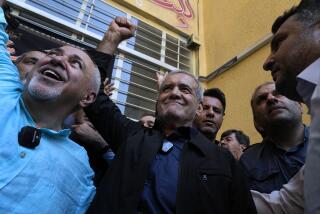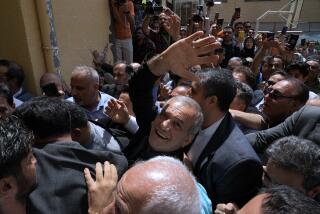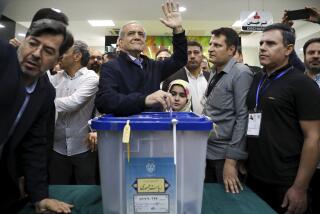Mousavi’s unlikely political journey
Iran’s economy stood in shambles and its international status was at a nadir. Disturbed by the leadership of then-President Ali Khamenei, Prime Minister Mir-Hossein Mousavi wrote him a letter and threatened to resign from his high-ranking post, according to news accounts at the time.
“The affairs of Lebanon, Iraq and Afghanistan are in your hands,” Mousavi’s 1988 missive reportedly said. “You know better how disastrous these have been to the country.”
Mousavi’s threat to resign was ignored, but within a year, he was shuffled aside from Iran’s political scene, spending the next two decades painting, reading and lecturing at universities.
Today, Mousavi, 67, finds himself again facing off against Khamenei, now the country’s supreme leader, as the figurehead of a surprise reform movement built around his own presidential election campaign and the widespread belief among his supporters and independent experts that the June 12 vote count was rigged in favor of incumbent Mahmoud Ahmadinejad.
As he ascends the international stage, Mousavi, however, is still very much a blank slate. In public, he remains soft-spoken, almost aloof, measuring his words carefully when he speaks, often awkwardly.
Such attributes may have helped him galvanize a diverse group that includes religious conservatives, worried about the creeping militarism and strident nationalism of the Ahmadinejad era, and secular liberals who would like to loosen Iran’s social and political restrictions and end its international isolation.
Yet Mousavi’s character also leaves his allies, opponents and independent analysts guessing about how far he’s willing to go, whether he will ultimately prove more loyal to the system that he helped establish and that molded him or to the followers who have gambled their liberty and even their lives to support him.
Under close supervision of authorities and denied access to state television or a newspaper, Mousavi has managed to occasionally get his message out. According to news accounts, he told those attending the rally Saturday that he was willing to sacrifice his own life to pursue his cause, though his supporters later denied that he had made such a statement.
Mousavi has called on his supporters to declare a national strike if he is arrested. But he also has made it clear that he is no opponent of the Islamic Republic.
“We are not against the Islamic system and its laws,” he said in a statement that appeared on his website at the end of Saturday’s clashes between security forces and protesters, “but against lies and deviations and just want to reform it.”
--
A long history
Mousavi and Khamenei know each other well. Not only did they chafe against each other’s authority frequently during the 1980s, they are relatives, with roots in the northwestern city of Khamein. They were both part of the Islamic movement that overthrew and replaced Shah Mohammad Reza Pahlavi and the monarchy. But they were at odds as leading members of rival factions.
“They had all sorts of problems when Mousavi was prime minister and Khamenei was president,” said Ali Reza Nourizadeh, an Iran expert in London. “Almost every day, they were fighting with each other.”
As prime minister from 1981 to 1989, Mousavi is generally credited for steering the country well during the years of war with Iraq, but some recall an unpredictable character unable to navigate the system and defeat his adversaries in Iran’s hard-knuckle factional politics.
“In his domestic policy he was not able to manage his own Cabinet let alone his foreign policy,” said Mohammed Esmaeel Haydari, a journalist. “Every single member of his Cabinet was linked to one faction of power and all of them were taking orders from [then-supreme leader Ayatollah Ruhollah Khomeini] and did not care what the prime minister said. In the war-stricken country he was a puppet whose strings were pulled by the clerical establishment. He was, in fact, a front for them.”
After the tumult of the revolution’s early years, Khamenei succeeded Khomeini as supreme leader, consolidating his power as he mastered the intricacies of Iran’s unique political system, which combines elements of a theocracy with that of a republic. He balanced faction against faction, cleric against cleric, cultivating ties with the military and winning the loyalty of the informal pro-government militias. By most accounts, his outlook also became more conservative.
Meanwhile, out of power, Mousavi reinvented himself, spending his two decades out of the political maelstrom studying and teaching at Tarbiat Modares University in Tehran, and then in 1998, taking over the presidency of the newly created Academy of Arts.
A painter and an architect, he devoted himself to the arts and later sold some of his works to raise money for his campaign. They are jumbles of abstract geometric shapes and flowers, incorporating elements of architecture and design into works that use light touches of color.
Before the revolution, Mousavi was a follower both of Khomeini and Iranian activist Ali Shariati, who combined Marxist and Islamist doctrine in speeches he presented at the Hosseinieh Ershad, a famous mosque in north Tehran.
But during the 1990s and since, Mousavi also began expanding his understanding of the world, acquainting himself with thinkers such as Michel Foucault, Juergen Habermas and Edward Said, according to Said Hosseinian, a friend and colleague who served in his campaign.
“He is an open-minded technocrat with religious ideology,” said Saleh Nikbakht, a Tehran attorney who knows him. “Though he admits that he follows the late Khomeini’s path, in fact he belongs to a moderate school with a nationalist democratic legacy and a tolerance of other opinions.”
Though Ahmadinejad fashions himself as a populist in support of the poor, Hosseinian said Mousavi always leaned toward the left in his outlook. “He believed the poor have suffered more than the others,” he said.
During the 1997 to 2005 presidency of his friend, reformist Mohammad Khatami, Mousavi began dabbling again in politics, serving as an informal speechwriter and behind-the-scenes advisor.
All along, he has had an extraordinary relationship with his wife, Zahra Rahnavard, a nationally venerated scholar, artist and educator who often appeared alongside him on the campaign trail and now speaks out for him at public events.
“She’s not passive, behind the wall. She’s very much in evidence and vocal,” said Anoush Ehteshami, an Iran expert at Durham University in Britain. She’s always been very well known and has got quite a following amongst the intellectuals.”
--
Symbol of unrest
In television appearances, Mousavi told viewers that he reentered political life because he was worried about the direction Ahmadinejad was taking the country.
He portrayed himself as someone who had been there at the beginning of the revolution and was now prepared to come back into the fray to save the nation from economic ruin and international isolation. He has voiced his commitment to Khomeini’s ideals but also dared to say that the Islamic Republic needs to resurrect promises of freedom, transparency, rule of law and democracy as well as Islam.
Unlike Khatami, who was thwarted in his pursuit to open Iran’s political system, some say, Mousavi is a die-hard who is prepared to go farther than the mild-mannered cleric.
“I think Mousavi is the man who is more prepared for this fight than Khatami would have been,” Ehteshami said.
But gusto may not be enough. To take on such powerful adversaries as Khamenei and Ahmadinejad, Mousavi must also have the political savvy to muster popular support and recruit institutional allies, experts say. Khamenei, who has emerged as Ahmadinejad’s No. 1 champion, has all those things, unlike Mousavi.
“Mousavi is not a charismatic guy,” said an analyst in Tehran, who spoke on condition of anonymity. “He became more and more liked by people as the campaign went on, but more as a symbol of people’s dissatisfaction.”
--
kim.murphy@latimes.com
Mostaghim is a special correspondent.
More to Read
Sign up for Essential California
The most important California stories and recommendations in your inbox every morning.
You may occasionally receive promotional content from the Los Angeles Times.










